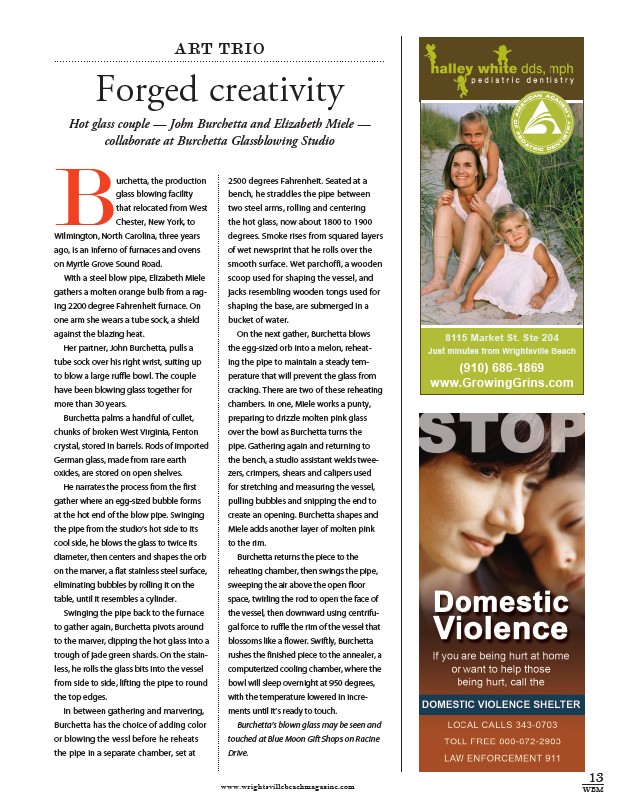
13
www.wrightsvillebeachmagazine.com WBM
Burchetta, the production
glass blowing facility
that relocated from West
Chester, New York, to
Wilmington, North Carolina, three years
ago, is an inferno of furnaces and ovens
on Myrtle Grove Sound Road.
With a steel blow pipe, Elizabeth Miele
gathers a molten orange bulb from a raging
2200 degree Fahrenheit furnace. On
one arm she wears a tube sock, a shield
against the blazing heat.
Her partner, John Burchetta, pulls a
tube sock over his right wrist, suiting up
to blow a large ruffle bowl. The couple
have been blowing glass together for
more than 30 years.
Burchetta palms a handful of cullet,
chunks of broken West Virginia, Fenton
crystal, stored in barrels. Rods of imported
German glass, made from rare earth
oxides, are stored on open shelves.
He narrates the process from the first
gather where an egg-sized bubble forms
at the hot end of the blow pipe. Swinging
the pipe from the studio’s hot side to its
cool side, he blows the glass to twice its
diameter, then centers and shapes the orb
on the marver, a flat stainless steel surface,
eliminating bubbles by rolling it on the
table, until it resembles a cylinder.
Swinging the pipe back to the furnace
to gather again, Burchetta pivots around
to the marver, dipping the hot glass into a
trough of jade green shards. On the stainless,
he rolls the glass bits into the vessel
from side to side, lifting the pipe to round
the top edges.
In between gathering and marvering,
Burchetta has the choice of adding color
or blowing the vessl before he reheats
the pipe in a separate chamber, set at
2500 degrees Fahrenheit. Seated at a
bench, he straddles the pipe between
two steel arms, rolling and centering
the hot glass, now about 1800 to 1900
degrees. Smoke rises from squared layers
of wet newsprint that he rolls over the
smooth surface. Wet parchoffi, a wooden
scoop used for shaping the vessel, and
jacks resembling wooden tongs used for
shaping the base, are submerged in a
bucket of water.
On the next gather, Burchetta blows
the egg-sized orb into a melon, reheating
the pipe to maintain a steady temperature
that will prevent the glass from
cracking. There are two of these reheating
chambers. In one, Miele works a punty,
preparing to drizzle molten pink glass
over the bowl as Burchetta turns the
pipe. Gathering again and returning to
the bench, a studio assistant welds tweezers,
crimpers, shears and calipers used
for stretching and measuring the vessel,
pulling bubbles and snipping the end to
create an opening. Burchetta shapes and
Miele adds another layer of molten pink
to the rim.
Burchetta returns the piece to the
reheating chamber, then swings the pipe,
sweeping the air above the open floor
space, twirling the rod to open the face of
the vessel, then downward using centrifugal
force to ruffle the rim of the vessel that
blossoms like a flower. Swiftly, Burchetta
rushes the finished piece to the annealer, a
computerized cooling chamber, where the
bowl will sleep overnight at 950 degrees,
with the temperature lowered in increments
until it’s ready to touch.
Burchetta’s blown glass may be seen and
touched at Blue Moon Gift Shops on Racine
Drive.
8115 Market St. Ste 204
Just minutes from Wrightsville Beach
(910) 686-1869
www.GrowingGrins.com
Art Trio
Forged creativity
Hot glass couple — John Burchetta and Elizabeth Miele —
collaborate at Burchetta Glassblowing Studio